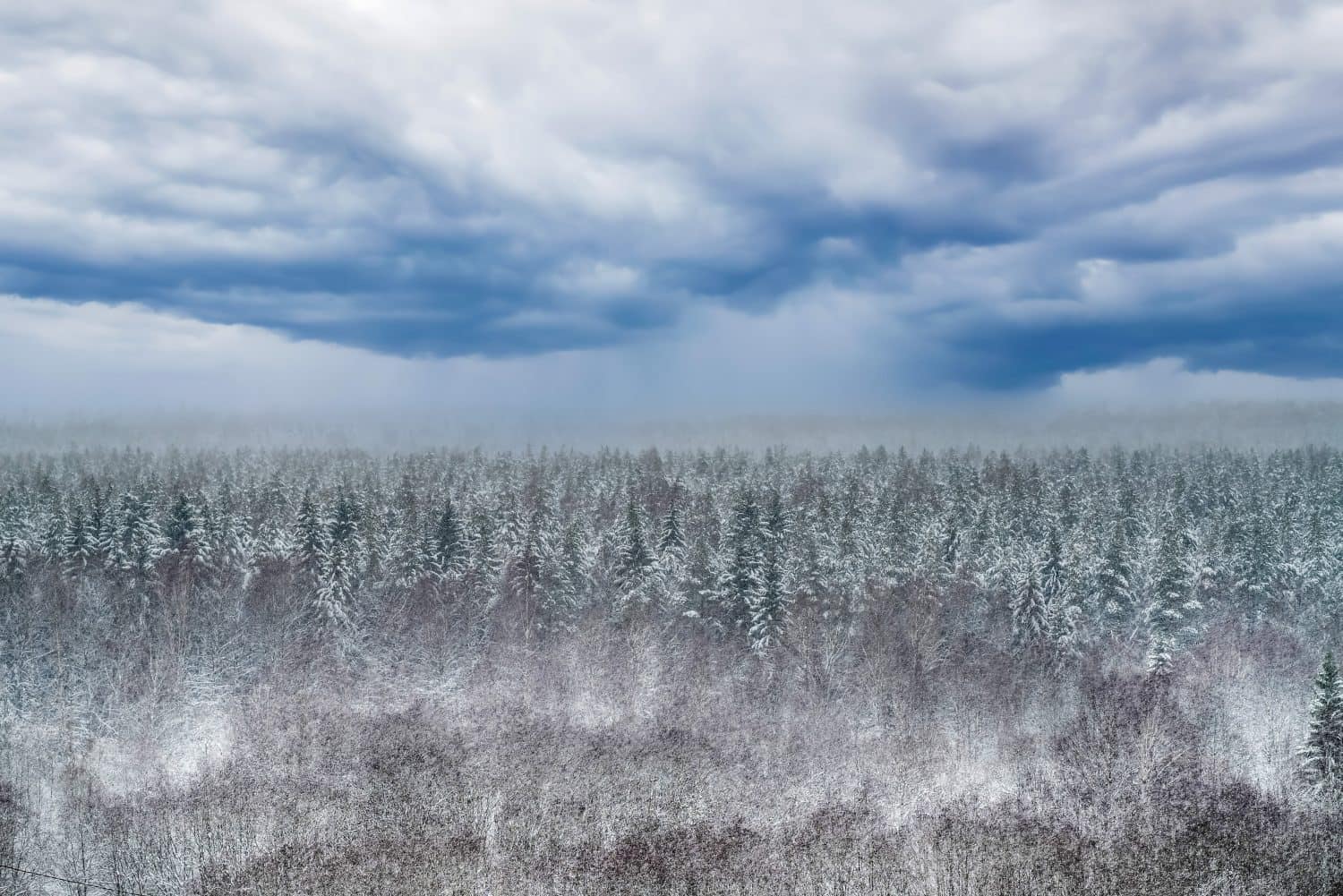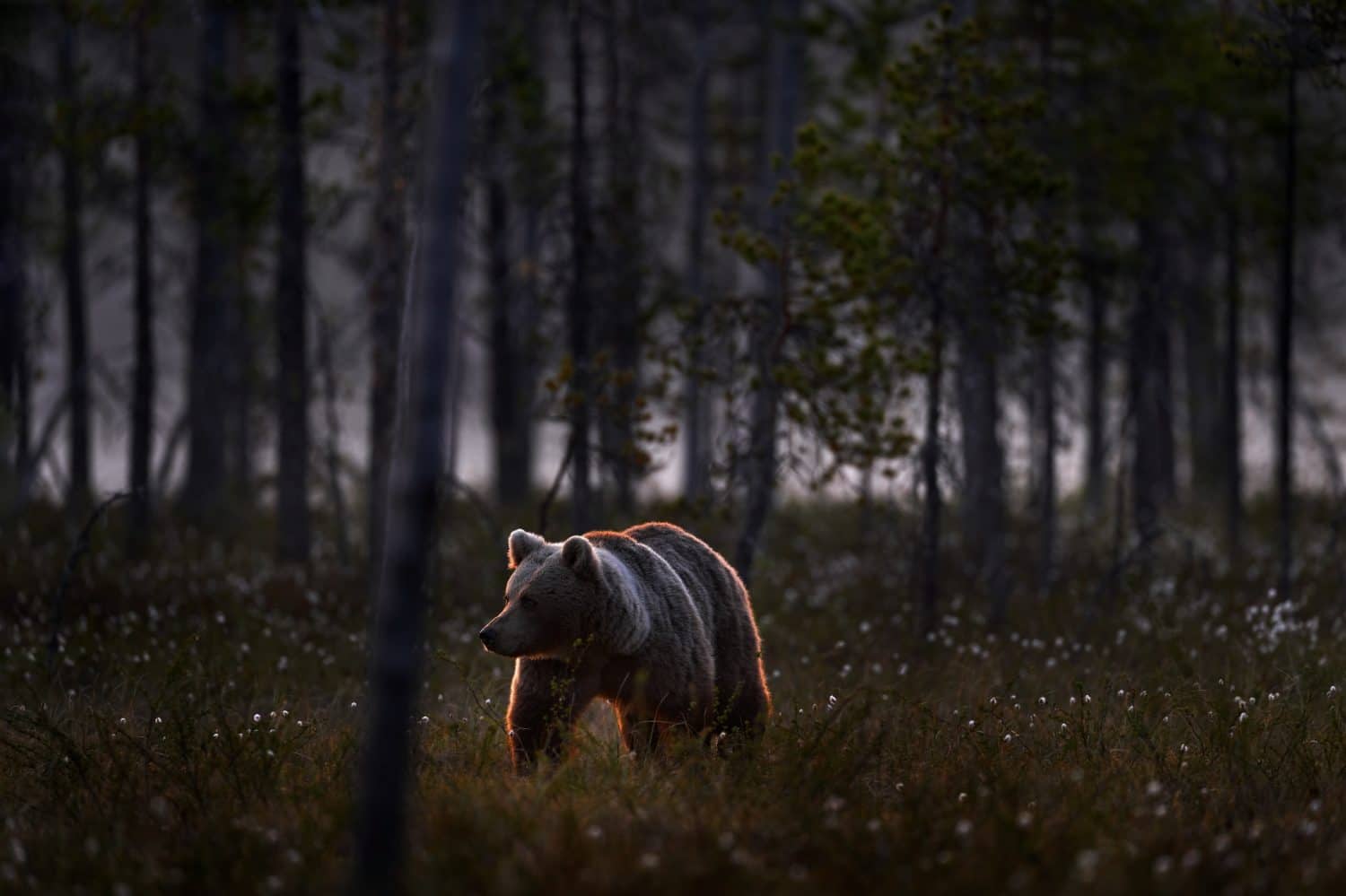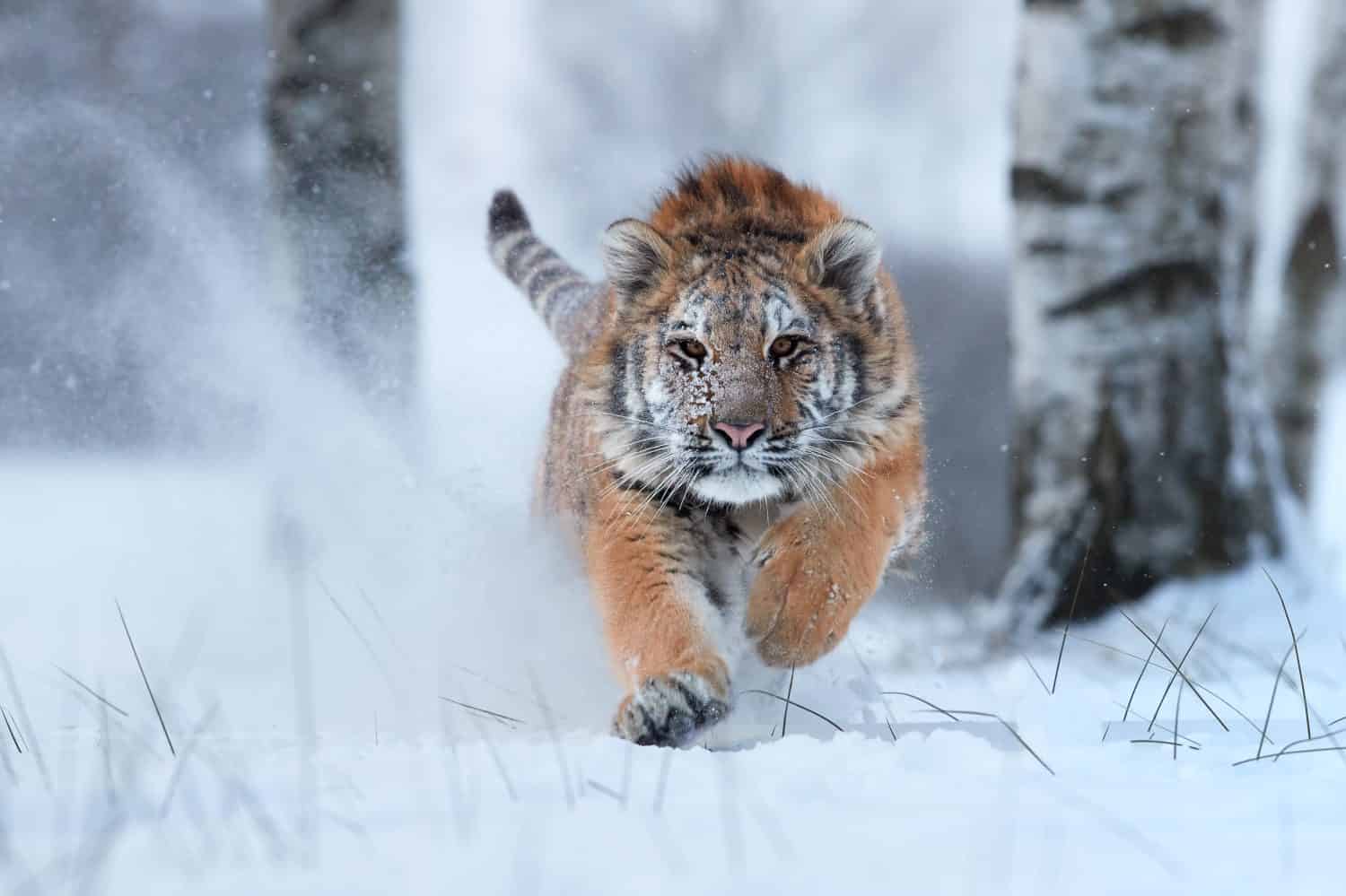Earth’s northernmost forests, known as the taiga (pronounced TY-GUH), stretch across the Northern Hemisphere like a belt. Life here is challenging for the plants and animals. However, they have all adapted in some way. Keep reading to discover how animals in the taiga survive the extreme winter cold through physical and behavioral adaptations.
What Is the Taiga?

The evergreen tree is one of the few tree types growing in the taiga.
©Evgenii Panov/Shutterstock.com
The taiga is the largest and second-coldest land biome on the planet. You can find the forested subarctic region in the Northern Hemisphere, south of the Arctic Circle. It’s wedged between the tundra up north and the temperate down south. It stretches across most of Canada and parts of Alaska, Asia, and Europe. However, the largest taiga is in Russia.
Sometimes referred to as the boreal forest or snow forest, the taiga is composed of coniferous trees such as spruce, pine, hemlock, and fir. Most of the trees growing in the taiga are evergreen, which have adapted to survive the extreme winter cold, much like the animals living here.
What Is the Climate Like in the Taiga?

Animals in the taiga have adapted to below-freezing winters and mild summers.
©Ondrej Prosicky/Shutterstock.com
Temperatures in winter can drop below 65 degrees Fahrenheit. Winters are long, with short days and temperatures below freezing for months. Chilly winds from the Arctic also blast the taiga throughout the season.
But the almost desolate forest thaws in summer with temperatures reaching 70 degrees Fahrenheit. Days are long and wet, attracting many insects that migrating birds feast on until the seasons change once again.
Even so, the ground is covered in a permafrost layer – permanently frozen soil. Bedrock is typically beneath this layer, preventing water on top from draining. The taiga sees 10 to 30 inches of precipitation throughout the year, falling as snow in winter and rain in summer.
Taigas have few plants because of the frozen, nutrient-deficient soil, with only the most resilient shrubs, mosses, lichens, flowers, and mushrooms surviving. The trees and plants have adapted well alongside the animals in the taiga, who have learned to survive the extreme winter cold in various ways.
In the following sections, you’ll discover who these animals are and how they’ve adapted to the unforgiving environment.
What Animals Live in the Taiga?

Brown bears are one of the animals that inhabit the wild taigas in Finland and Scandinavia.
©ArCaLu/Shutterstock.com
Despite the brutal winters of the taiga, many animals brave the weather. Those that leave when the temperatures plummet return once they warm up in spring and summer. In fact, many of the birds that call the taiga home lay their eggs here once the thick layers of snow melt.
On the other hand, small mammals living in taigas stay close to the ground, searching for food and hiding from predators among the snowdrifts. Large mammals roam the wilderness, taking shelter wherever they can and hunting for prey or edible plants.
Birds of prey staying for the winter get a top view of the winter wonderland below, easily locating hiding places for themselves and their next meal. Smaller birds who struggle to forage at night store seeds in their throat pouches, eating from their hard-earned reserves slowly throughout the night.
But that’s just a snapshot of life in the taiga. Here are some of the animals living in the taiga:
Mammals
- Arctic foxes
- Bears
- Beavers
- Bobcats
- Caribou
- Elk
- Ermine
- Lynx
- Moose
- Pine Marten
- Siberian tigers
- Snowshoe hare
- Wild boar
- Wolverines
- Wolves
Birds
- Bald eagles
- Crossbills
- Geese
- Grouse
- Owls
- Pileated woodpeckers
- Siberian cranes
- Sparrows
- Snow geese
- Taiga flycatchers
Fish
- Arctic graylings
- Chub
- Salmon
- Siberian taimen
- Walleye
How Do Animals in the Taiga Survive the Extreme Winter Cold?

Siberian tigers have thick fur coats that protect them from the extreme winter cold.
©Martin Mecnarowski/Shutterstock.com
Winters are long and harsh, requiring native species to adapt to the frigid temperatures. Some animals in the taiga survive through behavioral adaptations that take them away from the cold, while others rely on physical adaptations to keep them safe through the season. Below are a few ways animals in the taiga survive the extreme winter cold.
Physical Adaptations
Animals that have survived the extreme winter cold of the taiga for centuries have physically adapted to the environment. Many of them, such as Siberian tigers and wolves, grow thick winter coats to keep their bodies warm and insulated.
Arctic foxes have thick, white fur coats that keep them warm in winter and protect them from predators. Ermine and snowshoe hair also grow white fur in the winter as camouflage, shedding into a dark brown during summer.
Moose are so large the cold doesn’t bother them much, but they struggle to regulate their temperature during the hot, mosquito-infested summers.
Another physical adaptation that helps animals in the taiga survive the extreme winter cold involves their feet. For example, caribou have large hooves with two extended toes called “dew claws” to help them trek across the snow. In winter, the pads of their hooves shrink and harder to make it easier to walk on ice and reduce the amount of exposed skin. Once summer arrives, their hooves become soft and spongy for stability against the wet and soggy ground.
Hibernation
Other animals in the taiga survive the extreme winter cold by hibernating. In some cases, these animals enter a similar sleep-like state called torpor. Mammals such as brown and black bears, as well as rodents like chipmunks and squirrels, escape to their dens or burrows as fall turns to winter to sleep out the season.
During hibernation or torpor, animals experience slowed breathing and a drop in their heart rate and metabolism to prevent the need for food. Some animals sleep for months at a time, finally waking when the warmth of spring arrives.
Migration
Many birds originating from the taiga can’t survive the low temperatures and heavy snowfall. As a result, they migrate south to enjoy warmer climates during the bristling winters. A well-known example is the Canada goose. They fly from the taiga of northern Canada to as far south as Florida for food and shelter, returning to Canada again in summer to breed.
However, birds aren’t the only animals that migrate. Some caribou also migrate from as far north of the taiga’s border with the tundra to southern parts of Alaska and Canada in search of abundant lichens to eat. Caribou migration patterns rely heavily on the weather, with herds walking as far as 50 miles a day.
The photo featured at the top of this post is © Ondrej Prosicky/Shutterstock.com
Thank you for reading! Have some feedback for us? Contact the AZ Animals editorial team.






